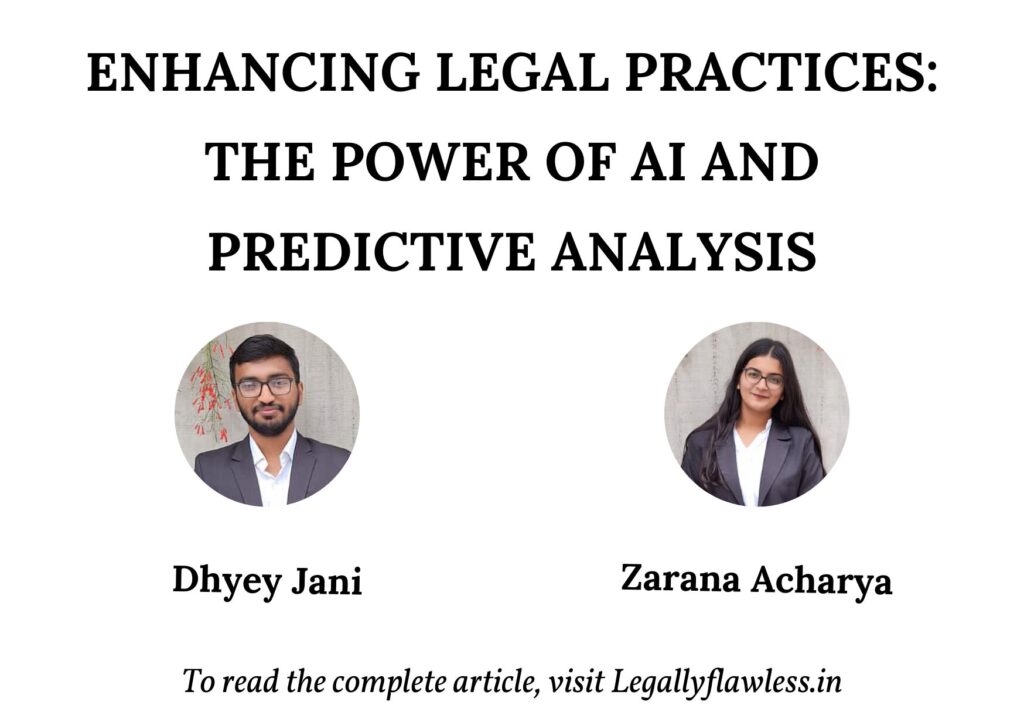
Table of Contents
Introduction
Artificial Intelligence (AI) is a diverse and magnificent field of computer science technology which focuses on developing intelligent machines accommodated with human intelligence that can perform tasks associated with human brain in an efficient manner.[1]In today’s world, machine learning and its advancements are driving the tech industry to an extraordinary level.AI, or Artificial Intelligence, is now an essential component of our contemporary world, driving innovation across numerous industries. It encompasses the development of computer systems capable of performing tasks that typically require human intelligence, influencing everything from virtual personal assistants and self-driving cars to healthcare diagnostics and recommendation algorithms. AI’s capacity to process large datasets, identify patterns, and make predictions has made it indispensable in sectors such as finance, healthcare, and marketing.[2]
Transitioning to the realm of justice administration, AI plays a pivotal role in revolutionizing the legal field. It modifies the methodology of research, judgement predictions, streamline document review, and enhance court management. These technologies are reframing the legal industry, by improving efficiency and inclusivity.
Predictive analytics is the process of using data and statistical algorithms to predict future events, trends, or outcomes. It involves analysing historical data to identify patterns and relationships, which can then be used to make informed predictions about future occurrences.
AI and predictive analytics are intricately linked, with AI serving as the enabling technology for predictive analytics. AI encompasses various techniques that mimic human intelligence, such as pattern recognition and learning from data. Predictive analytics, a specific application of AI, utilizes these capabilities to analyse historical data, identify patterns, and make forecasts about future events. Both AI and predictive analytics rely on data-driven decision-making, continuous learning, and automation, making them synergistic tools for harnessing data to make accurate predictions and automate complex tasks. [3]European Countries have already started incorporating AI in the Legal Domain. Many other developing countries including India, has been gradually exploring the potential of AI in various sectors including Law and Legal services. Though there have not been significant developments in the use of AI in Indian legal industry, it is possible that progress has been made since then.
The blog explores to trace the usage of AI and predictive analysis in Indian legal industry precisely in legal research, case prediction, document analysis, and access to justice. It draws the attention towards merits and probable, positive future advancements in these areas as well as its drawbacks. It highlights the implications of ethical and legal aspects of these technologies. Emphasising the usage of AI and Predictive Analysis, this blog attempts to answer the following questions:
- Firstly, what is the need of AI in the legal Industry?
- Secondly, what is the potential of AI in the Indian Legal Industry?
- Thirdly, can moral and ethical standards be maintained by making the use of AI in the justice delivering system?
Further, the blog concludes with a hope that a robust policy framework can ensure responsible usage of AI, balancing innovation, and ethical standards in the legal industry.
Use of AI and Predictive Analytics in Legal Domain
In the Indian legal industry, the integration of AI and predictive analytics has ushered in a transformative era, revolutionizing various facets of legal practice. AI’s application spans legal research, case prediction, document review, and access to justice, offering a wide range of benefits. AI aids legal professionals in efficiently analysing vast volumes of legal data, predicting case outcomes, streamlining document review, and enhancing access to justice for a broader segment of the population. This technological shift is not only driven by efficiency but also by the imperative to ensure fair and accessible legal services to all. As the Indian legal landscape evolves, AI and predictive analytics play a pivotal role in shaping a more inclusive and efficient legal system.[4]
Legal Research
Case Analysis
Several AI based tools like Lex Machina[5] and AI Lawyer[6] are utilized to analyse vast databases of legal cases, statutes, and precedents.Lex Machina’s data is compiled, cleaned, and enhanced by a unique combination of machine learning and in-house legal experts, and updated every 24 hours. The AI Lawyer app is a powerful legal tool that offers a range of cool features to help you work with legal documents and receive legal advice. With its natural language processing (NLP) algorithms, the app can quickly scan and analyse your documents, identifying important terms and clauses, and highlighting discrepancies between different versions of the same document. It can quickly extract relevant information, identify legal issues, and even predict potential outcomes based on historical data.
Legislations and Policies
AI can be employed to shift through and comprehend complex legislative documents and policies, allowing legal professionals to access and interpret these resources more efficiently.
Bylaws
Similar to legislations, AI can assist in comprehending intricate bylaws and municipal codes, aiding legal experts in understanding, and applying local laws effectively.[7]
Case Prediction and Outcome
Anticipating Court Decisions
Predictive analytics is used to forecast court decisions and their associated outcomes. This assists lawyers in assessing the likelihood of success in litigation and making informed decisions on whether to pursue a case or seek a settlement.
Assessing Potential Charges or Penalties
AI systems can help predict the potential charges or penalties that may arise from a legal case, allowing lawyers to advise their clients accordingly.
Settlement Predictions
Predictive analytics can identify cases that are likely to settle out of court, aiding in resource allocation and litigation strategy.[8]
Blue J L & E Software
A free trial software called Blue J L & E[9] has been developed to predict possible case outcomes which will help litigants analyse their case merits. It helps quickly identifies similar decisions based on factors and outcomes, rather than keywords. it identifies, manages, and provides access to the latest cases to deliver the most informed outcome.
Document Review
Efficient Document Review
AI tools like Humata AI[10] and Latch[11] streamlines the time-consuming and error-prone process of manually reviewing extensive volumes of legal documents. It can quickly and accurately extract pertinent information from large document repositories. Humata AI utilises the latest AI technology to perform various tasks through which it can synthesize the results based on natural language commands. It can summarize long papers and convert complex technical papers into simple easy to understand summaries.
Latch is an AI-powered tool that aims to assist legal teams in negotiating and finalizing contracts with greater speed and efficiency. It uses Open AI’s GPT-4 language model to analyse and understand agreements, offering suggestions on how to revise and update counterparty language based on a user’s standard position. The tool’s interface enables users to toggle between suggestions, accept them, and generate redlines automatically that can be inserted directly into the document. It also provides a question-and-answer feature to help users navigate through an agreement with granular questions and open-ended queries. Additionally, it can assemble simple, plain-language checklists for various situations, allowing users to analyse agreements to ensure compliance with their checklists.
An Indian firm, Cyril Amarchand Mangaldas are now leveraging the power of AI for contract analysis and review by partnering with Canadian AI assistant Kira Systems.[12]
Enhanced Accuracy
AI’s ability to analyse extensive data sets results in enhanced accuracy by reducing human errors, ensuring that relevant documents are identified swiftly.[13]
Speedy Access to Justice
AI-powered Chatbots
Chatbots equipped with AI are deployed to provide legal guidance and support to individuals who do not have access to legal representation. They can answer legal queries, guide users through legal processes, and offer general legal advice. Wusong Technology in China is working on digitizing the way Courts function using AI-enabled robot chatbot called “FaXiaotao” which offers users case analysis based on precedents and regulations and helps them locate lawyers. Visual Search and the CaseRanking algorithm to show the most relevant cases quickly. Startups like CaseMine and NearLaw are trying to reinvent legal research by using [14]
Enhancing Court Processes
AI is employed to analyse court data, identifying trends and patterns that can be used to improve court processes and outcomes. This aids in making the legal system more efficient and accessible to the public, ensuring speedy access to justice.[15]
These applications of AI and predictive analytics in the legal domain significantly enhance efficiency, accuracy, and accessibility while also potentially reducing costs. However, it is essential to address ethical and transparency concerns to ensure that these technologies are applied responsibly and fairly within the legal system.
The application of artificial intelligence and predictive analytics in law presents ethical and legal difficulties. A major concern is the possibility of AI replacing human judgement, which might have an influence on due process and the rule of law.
While AI and predictive analysis offer substantial benefits to the legal sector, they also pose significant drawbacks. The primary concern is the possibility of bias in AI models, which can reinforce pre-existing biases in training data and produce unjust results and social disparities. Additionally, the evaluation of accuracy and fairness is hampered by the lack of openness in AI decision-making. A heavy reliance on AI also runs the risk of undervaluing the vital contribution of human expertise and judgement to judicial processes. Balancing AI’s capabilities with the preservation of fairness, transparency, and human judgment is essential to effectively address these drawbacks.[16]
Advantages and Disadvantages of using AI
| Advantages | Disadvantages |
| 1. Rapid analysis of extensive data | 1. Potential for bias in data and predictions |
| 2. Efficient comprehension of complex information | 2. Lack of transparency in AI decision-making |
| 3. Informed decision-making | 3. Risk of overreliance on AI predictions |
| 4. Resource allocation optimization | 4. Accuracy dependent on data quality |
| 5. Time and cost savings | 5. Ethical concerns regarding AI influence |
| 6. Enhanced accuracy | 6. Job displacement in manual review |
| 7. Increased accessibility to support | 7. Initial setup and training costs |
| 8. Improved processes and outcomes | 8. Privacy concerns with data collection |
| 9. Streamlining document review and analysis | 9. Ongoing maintenance requirements |
These applications of AI and predictive analytics offer significant advantages in terms of efficiency, accuracy, and accessibility within the legal domain. However, they also present challenges related to bias, transparency, overreliance, ethical concerns, potential job displacement, privacy, and ongoing maintenance. Addressing these issues is crucial to ensure responsible and fair use of these technologies in the legal system.
Achieving the goal of maintaining moral and ethical standards in the use of AI in justice delivery system requires careful design, transparency, and oversight of AI systems. Ethical guidelines should be integrated into AI development, focusing on fairness, transparency, accountability, and bias mitigation. Regular audits and reviews of AI algorithms can help ensure adherence to these standards. Additionally, human judgment should complement AI, particularly in complex and morally sensitive cases, to uphold ethical principles and safeguard against potential biases or errors. With responsible implementation and continuous monitoring, AI can enhance the justice system while upholding moral and ethical standards.[17]
Potential future developments
The future of AI in the Indian legal industry holds great promise, with potential developments and trends that can further transform and enhance the sector. Here are some potential future developments of AI in the Indian legal industry:
- Advanced Legal Research: AI-powered legal research tools will continue to evolve, offering even more sophisticated analysis of case law, statutes, and legal documents. These tools may provide real-time updates on legal developments, helping lawyers stay current with the latest legal trends and precedents.
- Natural Language Processing (NLP) for Contracts: NLP-based AI systems will become increasingly proficient in contract analysis and management. They will be able to extract key clauses, identify potential risks, and even suggest revisions or updates to contracts, saving lawyers time and reducing the likelihood of errors.[18]
- AI-Powered Virtual Legal Assistants: Virtual legal assistants powered by AI and natural language understanding will become more prevalent. These AI chatbots or virtual assistants can provide instant answers to common legal queries, assist with legal paperwork, and guide individuals through legal processes.
- Predictive Analytics for Dispute Resolution: AI-driven predictive analytics will continue to improve in accuracy. Lawyers and judges can use these tools to anticipate case outcomes, helping with settlement negotiations and resource allocation within the legal system.[19]
- Enhanced Privacy and Data Protection Tools: Given the increasing importance of data privacy and protection laws, AI tools specialized in ensuring compliance with regulations like GDPR and India’s Data Protection Bill will be in demand. These tools can assist organizations in managing and safeguarding sensitive data.[20]
- Ethical AI and Bias Mitigation: As the legal industry relies more on AI, there will be a growing focus on ethical AI practices and bias mitigation. Ensuring that AI systems are fair and unbiased in their decision-making will be a top priority.[21]
- Integration with Blockchain: AI can be integrated with blockchain technology to enhance the security and transparency of legal transactions, such as smart contracts. This combination can ensure the immutability of legal agreements and reduce the need for intermediaries.[22]
- Government Adoption: Government bodies may adopt AI for more efficient and accessible public services, including legal aid and dispute resolution. AI-powered platforms could provide legal information, assist in filing legal documents, and support citizens in navigating the legal system.
- Cross-Border Legal Services: AI can facilitate cross-border legal services by assisting lawyers in understanding and navigating different legal systems and international regulations.
It is important to note that the successful integration of AI in the Indian legal industry will require collaboration between legal professionals, technologists, and policymakers. Addressing legal, ethical, and regulatory challenges will be crucial to realizing the full potential of AI while ensuring fairness and justice within the legal system. Additionally, as AI evolves, continuous learning and adaptation will be essential for legal professionals to make the most of these technological advancements.[23]
Conclusion
The integration of AI and predictive analytics in the Indian legal industry is transformative, reshaping legal research, case prediction, document analysis, and access to justice. AI enhances legal research by extracting information and predicting outcomes, which helps in staying updated with evolving legal trends. Predictive analytics assists lawyers in anticipating court decisions and resource allocation. AI streamlines document review, saving time and improving accuracy, while AI-powered chatbots provide legal guidance and support, promoting inclusivity. However, challenges like bias, transparency, and overreliance on AI must be addressed. The future holds promise with advanced tools and government adoption, but ethical practices and continuous education are crucial. A robust policy framework is needed to ensure responsible usage of AI, balancing innovation, and ethical standards in the legal industry.[24]
This article is authored by Ms. Zarana Acharya and Mr. Dhyey Jani, students at the Institute of Law, Nirma University, Ahmedabad.
[1] Russell, S. J., & Norvig, P. Artificial Intelligence: A Modern Approach (4th ed. Pearson, 2021).
[2] Schorer, A. (2023). Artificial Intelligence (AI): What Is AI and How Does It Work? Built In. Available at: https://builtin.com/artificial-intelligence/
[3] Halton, C. (2023) Predictive analytics: Definition, model types, and uses, Investopedia. Available at: https://www.investopedia.com/terms/p/predictive-analytics.asp
[4] Banerji, O. (2021) Role of artificial intelligence in law, impleaders. Available at: https://blog.ipleaders.in/role-of-artificial-intelligence-in-law/
[7] Barker, H., Baxter, B. and Spoto, M. (2023) How artificial intelligence is used in legal practice, Bloomberg Law. Available at: https://pro.bloomberglaw.com/brief/ai-in-legal-practice-explained/
[8] Heshmat, A. (2023) Use of AI in law firms to predict litigation outcomes: LexisNexis blogs, LexisNexis. Available at: https://www.lexisnexis.co.uk/blog/future-of-law/using-ai-to-predict-litigation-outcomes
[9] https://www.bluej.com/ca/bluej-le
[11] https://www.latchapp.com/
[12] Jain, Parth, Artificial Intelligence for Sustainable and Effective Justice Delivery in India (June 30, 2018). OIDA International Journal of Sustainable Develospment, Vol. 11, No. 06, pp. 63-70, 2018, Available at SSRN: https://ssrn.com/abstract=3284903
[13] Legal Newswire (2023) The future is here: Ai and legal document review, Legal Newswire. Available at: https://www.law.com/legalnewswire/post-detail/the-future-is-here-ai-and-legal-document-review/
[14] Jain, Parth, Artificial Intelligence for Sustainable and Effective Justice Delivery in India (June 30, 2018). OIDA International Journal of Sustainable Development, Vol. 11, No. 06, pp. 63-70, 2018, Available at SSRN: https://ssrn.com/abstract=3284903
[15] Vasanth Rajasekaran & Harshvardhan Korada (2023) Ai in law: Revolutionising Justice or perpetuating risks? BusinessLine. Available at: https://www.thehindubusinessline.com/business-laws/ai-in-law-revolutionising-justice-or-perpetuating-risks/article66494626.ece
[16] Altlaw (2023) The disadvantages of ai in law and how to avoid them, Altlaw eDiscovery. Available at: https://www.altlaw.co.uk/blog/the-disadvantages-of-ai-in-law-and-how-to-avoid-them
[17] Ai and law: What are the ethical considerations? (2023) Clio. Available at: https://www.clio.com/resources/ai-for-lawyers/ethics-ai-law/
[18] Flynn, S. (2021) How natural language processing (NLP) AI is used in law, Law Technology Today. Available at: https://www.lawtechnologytoday.org/2021/06/how-natural-language-processing-nlp-ai-is-used-in-law/
[19] Predictive data analysis for litigation Available at: https://Predictive data analysis for litigation https://inview.lawvu.com/blog/predictive-data-analysis-for-litigation (Accessed: 15 September 2023).
[20] MacCarthy, M. et al. (2023) Protecting privacy in an AI-Driven World, Brookings. Available at: https://www.brookings.edu/articles/protecting-privacy-in-an-ai-driven-world/
[21] Mohanty, S.C., and I. (2023) The importance of bias mitigation in AI: Strategies for Fair, ethical AI systems, UXmatters. Available at: https://www.uxmatters.com/mt/archives/2023/07/the-importance-of-bias-mitigation-in-ai-strategies-for-fair-ethical-ai-systems.php
[22] Murillo, A.M. (2022) Artificial Intelligence and Blockchain: Debate around legal challenges, IntechOpen. Available at: https://www.intechopen.com/chapters/83588
[23] editor, A. (2023) Legal ai’d, Law.asia. Available at: https://law.asia/potential-generative-ai-for-legal-profession/
[24] Raghavan, Meera. “The future of legal technology: Predictive analytics in the legal profession.” Vanderbilt Journal of Entertainment and Technology Law, vol. 20, no. 2, 2018, pp. 373-408.
All efforts are made to ensure the accuracy and correctness of the information published at Legally Flawless. However, Legally Flawless shall not be responsible for any errors caused due to oversight or otherwise. The users are advised to check the information themselves.


